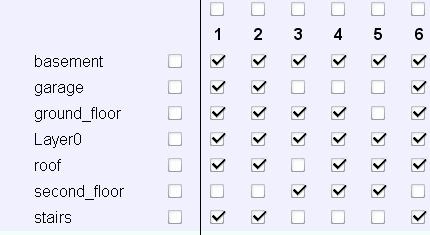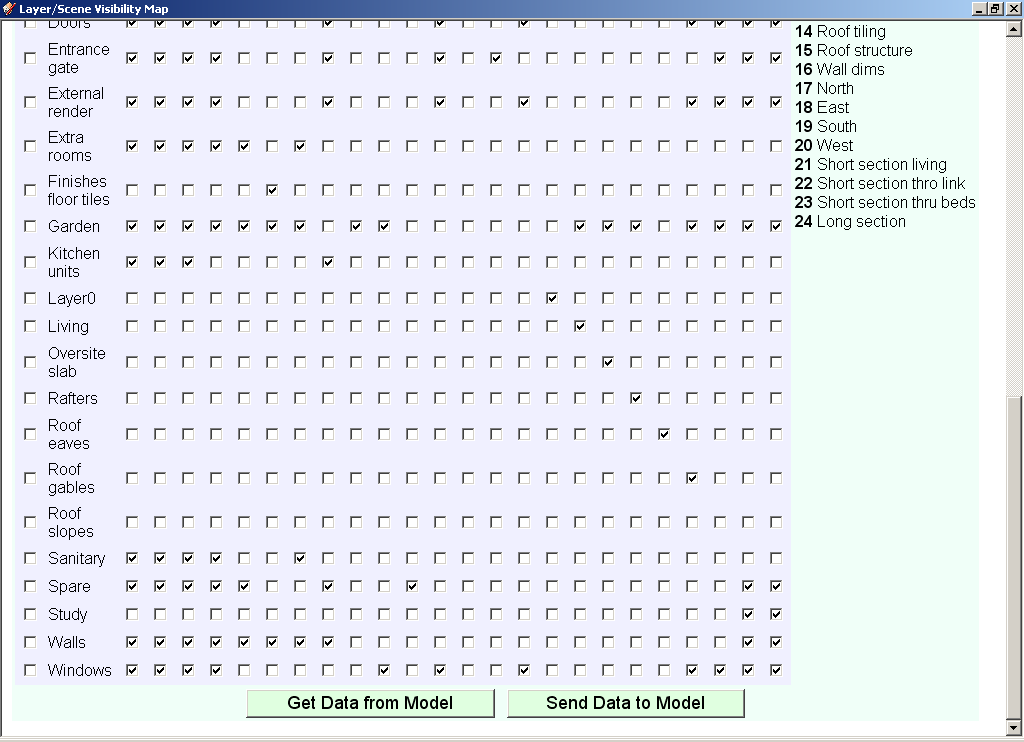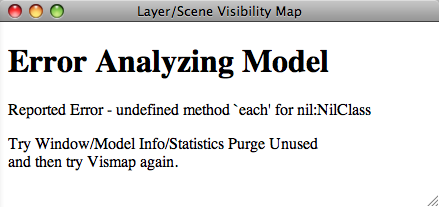[Plugin] VisMap - Layer/Scene Visibility Map
-
Like this:

-
I like Jim's layout better, but would still prefer Layer(0) at the beginning (but that's not a show stopper).
-
@bob james said:
I like Jim's layout better, but would still prefer Layer(0) at the beginning (but that's not a show stopper).
Forgive me if I have missed something but isn't layer0 always going to have to be the active layer and should not appear at all? If not it seems there will be lots of complications with reassignment/hiding.
Both seem to ignore the scene name problem!
Chris
-
'Layer0' is most often used as the current layer - you then put 'assembled' groups/components/etc on other layers to control visibility. However, you can set any layer as the 'active' one BUT it's not recommended without a good reason... An example would be you are puttings dimensions on the model and want them all to be on layer 'DIMS' - make that the active layer, add the dimensions [you can then switch them on and off separated from everything else] BUT remember to go back to active=Layer0 afterwards otherwise chaos will ensue...
-
@tig said:
'Layer0' is most often used as the current layer - you then put 'assembled' groups/components/etc on other layers to control visibility. However, you can set any layer as the 'active' one BUT it's not recommended without a good reason...
Ah yes I should have written ... "always going to have to be the active layer" when using VisMap
-
@chrisglasier said:
"always going to have to be the active layer" when using VisMap
Actually, Chris, I'd turn Layer0 off, if I could. In my tutorial I teach the common gospel re Layer0, but I don't believe it. I consider a model incomplete until Layer0 is empty.
-
@martinrinehart said:
@chrisglasier said:
"always going to have to be the active layer" when using VisMap
Actually, Chris, I'd turn Layer0 off, if I could. In my tutorial I teach the common gospel re Layer0, but I don't believe it. I consider a model incomplete until Layer0 is empty.
Yes I agree, empty, active and not an option in VisMap! Otherwise if you try and hide another layer that is active you will get an alert "You cannot hide an active layer" or something like that.
-
Sorted layer names.
These two are not in the .zip yet. Please rename "vismap.txt" to "vismap.js", try them in .../Plugins/Vismap and let me know.
Thanks.
-
@martinrinehart said:
Sorted layer names.
These two are not in the .zip yet. Please rename "vismap.txt" to "vismap.js", try them in .../Plugins/Vismap and let me know.
Thanks.
Just in case you want feedback here are two screenshots. Layer0 is empty, active and visible in all scenes. Some other layers also seem incorrectly checked - awkward to crosscheck though.


Perhaps the VIs strings did not get sorted (see top row, which was presumably previously level0).
And you really ought to address the awkwardness of the scene names and disappearing headers and unnecessary buttons (in my opinion,of course!).
Chris
-
Alphabetizing works great.

It still has a problem with pre-existing models with many layers and many scenes. I tried a new approach: I deleted all but one scene and re-saved the model with a different name. VisMap still would not load the layer names. (see attached)
Another request: Since you can have multiple models open at the same time, wouldn't it be a good idea to have the file name in the VisMap dialog box title?

-
-
@chrisglasier said:
Perhaps the VIs strings did not get sorted (see top row, which was presumably previously level0).
Can you send me a model? Post here or MartinRinehart at gmail dot com.
@chrisglasier said:
And you really ought to address the awkwardness of the scene names and disappearing headers and unnecessary buttons (in my opinion,of course!).
Ground-up rebuild, but not anytime soon. Scene names should be in a separate window you can move/size to suit. Title should be in a frame you can fold away. Scene #s should be frozen. You should have Ctrl/+, Ctrl/- to adjust size....
-
-
@unknownuser said:
The Layers SU Window is small, redimensionable, fully interactive and has a table scrolling. Furthermore, it allows to add / remove layers and configure them dynamically. You will miss however the Sorting into alphabetical order! Fredo
Just for the sake of good order:
On a PC you can sort layers alphabetically by clicking on "Name."
Pedantically
Chris
-
Thanks to you guys, I've now reproduced the issue in a modest model. Probably closing in on the solution, though I won't be on it any longer, today.
-
@chrisglasier said:
Just for the sake of good order:
On a PC you can sort layers alphabetically by clicking on "Name."
Pedantically
Chris
Chris, You are right actually. You can also sort them by visible / invisible and by color.
We should sometime look at what the SU engineers are doing in the native application
Fredo
-
@chrisglasier said:
Please download sceneModel R1.4.zip from here.
Page not found
We're sorry, but we were unable to locate the page you requested.
-
@bob james said:
@chrisglasier said:
Please download sceneModel R1.4.zip from here.
A Google alert this morning Hong Kong time says it has recovered the page (I must have made some balls up with the new R1.05 plugin attachment), and it seems OK from here. I have also sent a copy of the zip as a reply to your email.
Thanks (and apologises).
Chris
PS Martin did you have the same problem?
-
Gentlemen:
This pair should be smarter about which boxes are initially checked.
-
it did not work for me on mac.

Advertisement







